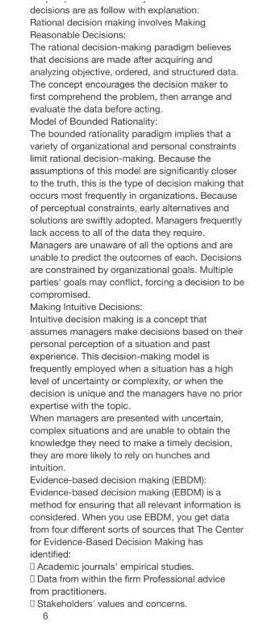Answered step by step
Verified Expert Solution
Question
1 Approved Answer
According to the manager we have interviewed, the perspectives which they use to make better decisions are as follow with explanation: Rational decision making



According to the manager we have interviewed, the perspectives which they use to make better decisions are as follow with explanation: Rational decision making involves Making Reasonable Decisions: The rational decision-making paradigm believes that decisions are made after acquiring and analyzing objective, ordered, and structured data. The concept encourages the decision maker to first comprehend the problem, then arrange and evaluate the data before acting. Model of Bounded Rationality: The bounded rationality paradigm implies that a variety of organizational and personal constraints limit rational decision-making. Because the assumptions of this model are significantly closer to the truth, this is the type of decision making that occurs most frequently in organizations. Because of perceptual constraints, early alternatives and solutions are swiftly adopted. Managers frequently lack access to all of the data they require. Managers are unaware of all the options and are unable to predict the outcomes of each. Decisions are constrained by organizational goals. Multiple parties' goals may conflict, forcing a decision to be compromised. Making Intuitive Decisions: Intuitive decision making is a concept that assumes managers make decisions based on their personal perception of a situation and past experience. This decision-making model is frequently employed when a situation has a high level of uncertainty or complexity, or when the decision is unique and the managers have no prior expertise with the topic. When managers are presented with uncertain, complex situations and are unable to obtain the knowledge they need to make a timely decision, they are more likely to rely on hunches and intuition. Evidence-based decision making (EBDM): decisions are as follow with explanation: Rational decision making involves Making Reasonable Decisions: The rational decision-making paradigm believes that decisions are made after acquiring and analyzing objective, ordered, and structured data. The concept encourages the decision maker to first comprehend the problem, then arrange and evaluate the data before acting. Model of Bounded Rationality: The bounded rationality paradigm implies that a variety of organizational and personal constraints limit rational decision-making. Because the assumptions of this model are significantly closer to the truth, this is the type of decision making that occurs most frequently in organizations. Because of perceptual constraints, early alternatives and solutions are swiftly adopted. Managers frequently lack access to all of the data they require. Managers are unaware of all the options and are unable to predict the outcomes of each. Decisions are constrained by organizational goals. Multiple parties' goals may conflict, forcing a decision to be compromised. Making Intuitive Decisions: Intuitive decision making is a concept that assumes managers make decisions based on their personal perception of a situation and past experience. This decision-making model is frequently employed when a situation has a high level of uncertainty or complexity, or when the decision is unique and the managers have no prior expertise with the topic. When managers are presented with uncertain, complex situations and are unable to obtain the knowledge they need to make a timely decision, they are more likely to rely on hunches and intuition. Evidence-based decision making (EBDM): Evidence-based decision making (EBDM) is a method for ensuring that all relevant information is considered. When you use EBDM, you get data from four different sorts of sources that The Center for Evidence-Based Decision Making has identified: Academic journals' empirical studies. Data from within the firm Professional advice from practitioners. Stakeholders' values and concerns. 6 i want to make a presentation regarding this intuition part kindly let me know what points should I include in Presentation on Power Point and what should I speak? both should differ and please make sure it's good enough because its a final project here it is:
Step by Step Solution
★★★★★
3.47 Rating (163 Votes )
There are 3 Steps involved in it
Step: 1
Title of the Presentation Making Intuitive Decisions Exploring the Benefits and Challenges Presentation Outline I Introduction A Definition of Intuitive Decision Making B Overview of Benefits and Chal...
Get Instant Access to Expert-Tailored Solutions
See step-by-step solutions with expert insights and AI powered tools for academic success
Step: 2

Step: 3

Ace Your Homework with AI
Get the answers you need in no time with our AI-driven, step-by-step assistance
Get Started


